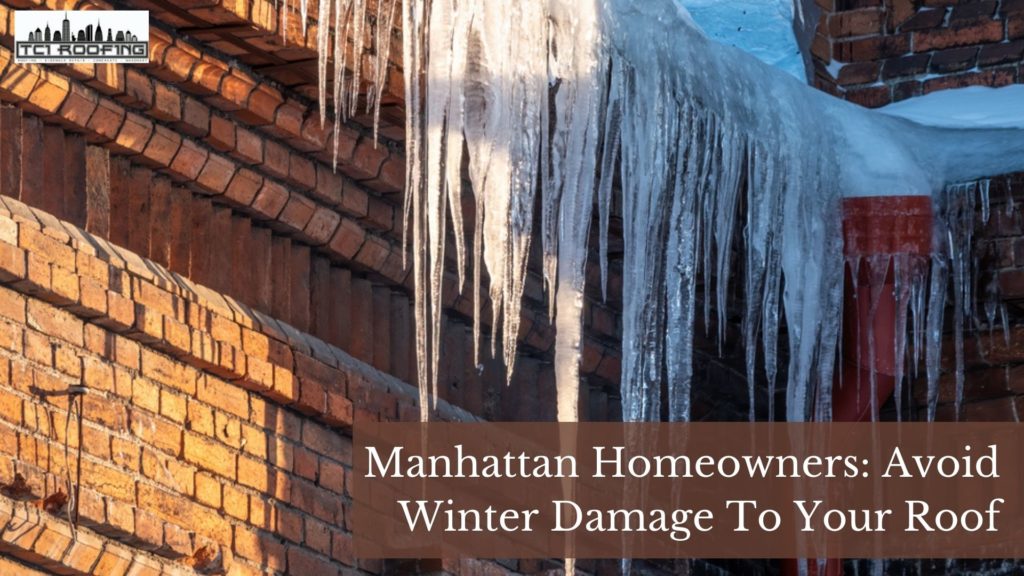Your roof in Manhattan is constantly working to protect you and your family from the elements. Will it, however, be able to withstand another Manhattan winter season?
There’s always the potential of unexpected repairs because of roof winter damage, as ice and snow accumulate on your flat roofs. The good news is that you may avoid expensive repairs by contacting a professional roofing contractor to carefully remove ice and snow from your roof before harm occurs.
Here’s how to keep your roof in good shape throughout the colder months.
Causes of Roof Damage
The effects of winter weather on your home can be severe. Some roof repairs due to snow roof damage are inexpensive, but others might cost thousands of dollars. For example, repairing a shingle roof will cost around $575, while replacing an asphalt roof due to ice and snow damage will cost up to $6,000.
The following are some of the issues to be aware of:
Snow Load
The accumulation of ice and snow on your roof does not take long. However, this extra weight can quickly damage roof gutters and shingles and cause structural damage if left unattended for an extended period. In addition, poor roof drainage or construction can exacerbate the problem, resulting in an over-stressed roof that begins to creak, leak, and droop the ceiling.
Water Leaks
Water runoff can occur as ice and snowmelt due to moist air and heat from your home’s interior. Water can soak through shingles and into the roof structure, causing minor leaks in the attic and insulation damage.
Ice Dams
Warm air from your attic heats the underside of your roof, melting the ice and snow that has accumulated above it. It can swiftly re-freeze when melted ice and snow are trapped, forming ice dams along roof edges, downspouts, and gutters. These dams can hinder the flow of melting snow, resulting in water pooling on the roof and shingle damage. In addition, water that has accumulated in your attic can seep down into your living rooms and through the ceilings.
Removing Ice and Snow
It can alleviate many winter roof difficulties by removing ice and snow accumulations, but it’s better to leave snow removal to a professional who can do it safely.
Using a conventional snow shovel to remove snow is not only unsafe but may also cause more damage to the roof. Although it may be tempting to melt ice and snow using calcium chloride or rock salt, both can harm shingles and violate any manufacturer’s guarantee.
Downspouts and Gutters
In the winter, ice builds up in downspouts and gutters. When the temperature drops, any dirt in the spouts and gutters causes melting water to back up and freeze. Keep the gutter system clean and free of leaves and other debris by regularly cleaning it to avoid this issue.
Skylights
Snow covers “weep holes,” the perforations put around the margins of the glass, which creates difficulty for skylights during the winter months. In addition, condensation can accumulate on the interior of these openings when they are covered, allowing water to drip into your home. When hiring a snow removal professional, make sure to inform them that you have skylights that require special attention to prevent damage.
Call a roofing contractors in NYC to avoid roofing difficulties this winter.
How to Prevent Ice Dams
When the snow and ice melt, it runs down your roof and freezes again along the edge, forming ice dams and icicles. This only happens when a portion of your roof warms up to over 32 degrees F, hot enough to melt the snow, while the roof edge remains below freezing. A heated attic is a common cause of this situation.
In most houses, heat flows through the ceilings into the attic floor, warming the wood and shingles directly above it. The snow melts over the warmed area of the roof, even if the outside temperature is below freezing. The meltwater reaches the frigid edge of the roof that is not warmed by the attic as it travels down the roof. It freezes there, forming an icy ring. This rim can expand and trap more water behind it, resulting in an ice dam.
Ice dams are difficult to remove, so try to avoid them altogether. Keep your attic and roof chilly to avoid ice dams but you can further reduce the risk by clearing out gutters and downspouts in the late fall and removing snow from the roof’s edges with a roof rake. A frigid roof will be blanketed in snow after a snowfall. On the other hand, a warmer roof will have clear places where the snow has melted off and icicles hanging from the eaves in no time.
Use Heated Cables
The ideal technique to prevent ice dams is improving ventilation and reducing heat sources against the inner roof surface. However, if these measures aren’t feasible, an electric heat cable can be installed along the roofline and gutters.
When the heat cable is coiled in a zig-zag pattern around the roof’s edge, melting water will not cool enough to freeze when it reaches the eaves. As a result, the meltwater does not freeze and instead harmlessly flows to the ground.
Heat cable is unsightly on a roof, but it helps avoid ice jams when appropriately connected. But keep in mind that combining water and electricity is always dangerous. So you keep the heating cable safe. Make sure to follow the manufacturer’s instructions to the letter and maintain it appropriately.
Call a reputable roofing contractor in Manhattan NY like ours, TCI Manhattan, to avoid roofing troubles this winter. For more than 20 years, we at TCI Manhattan Roofing Repair Services NYC has been taking care of all of the roofing needs. During your roof check, we make sure we don’t overlook anything. We’ll do everything we can to put your mind at ease on this winter season. Contact us today!

